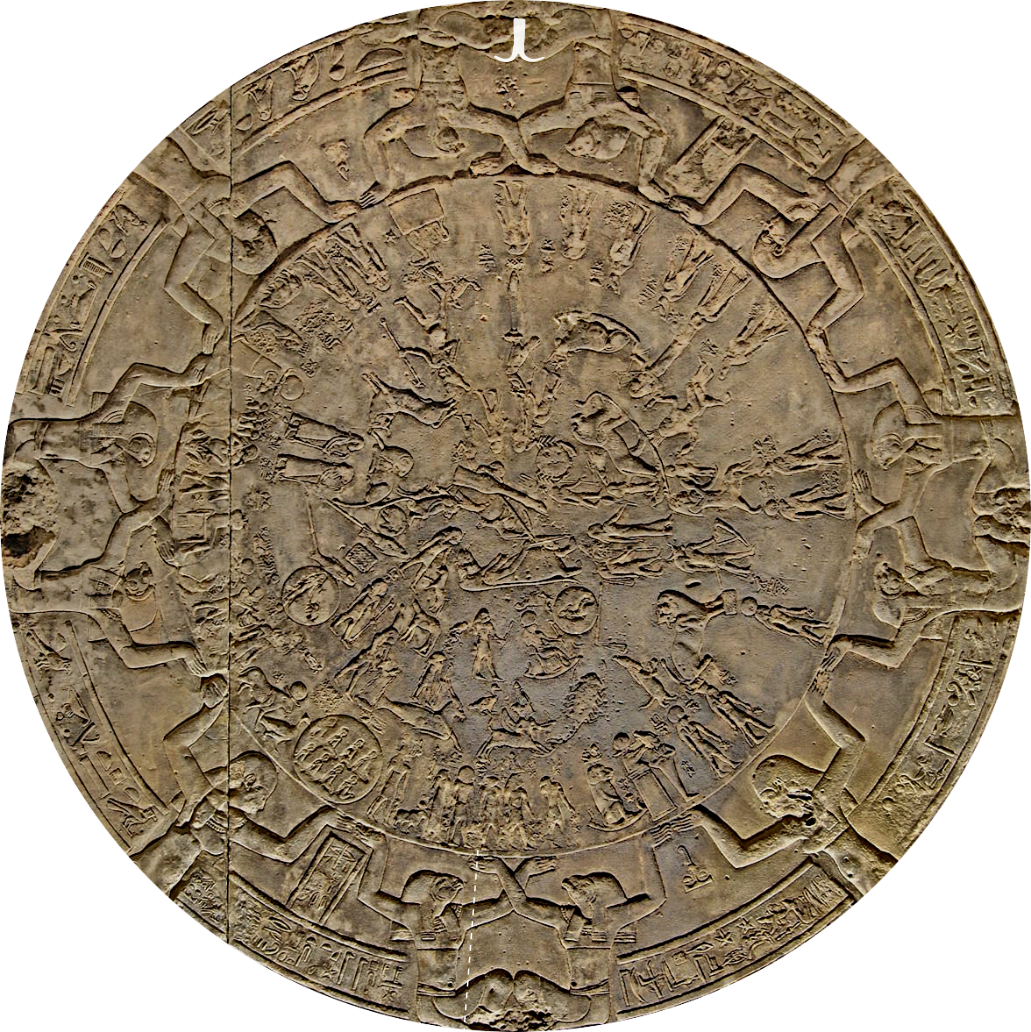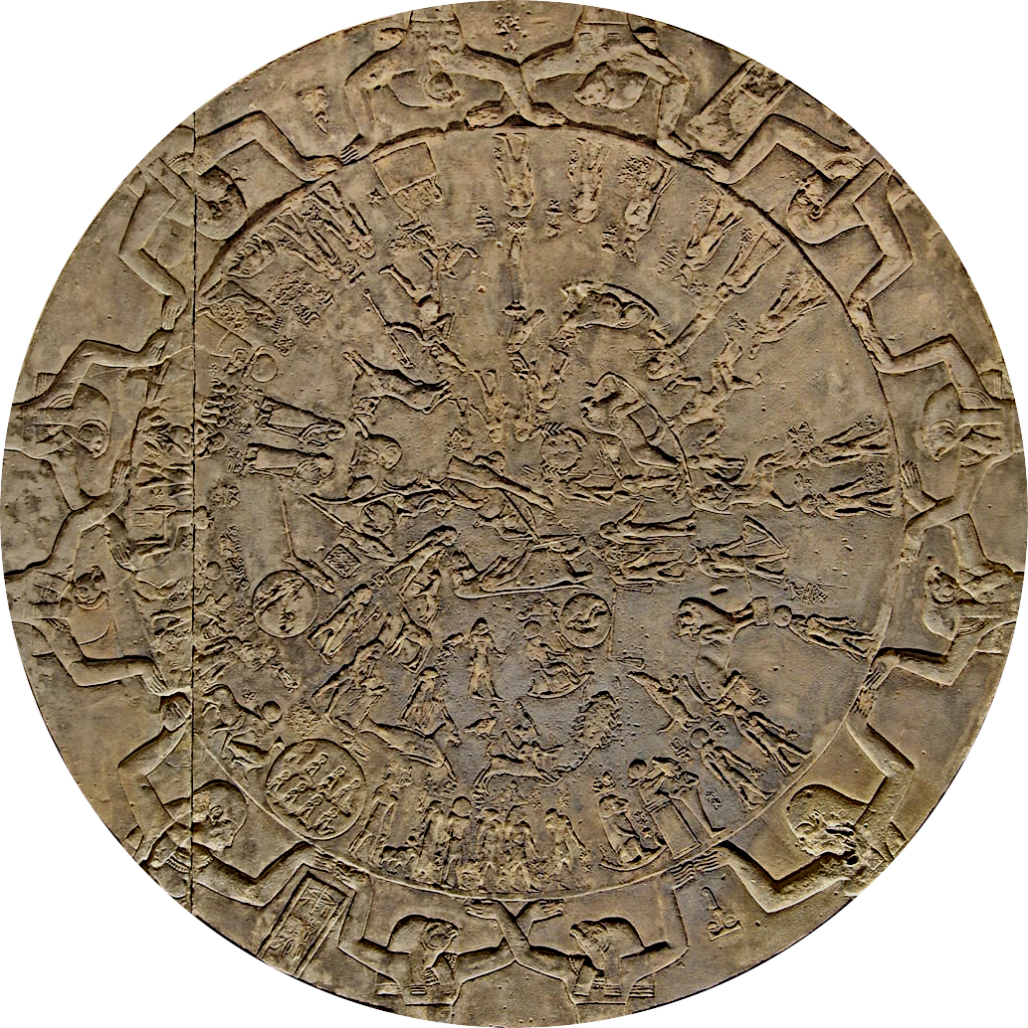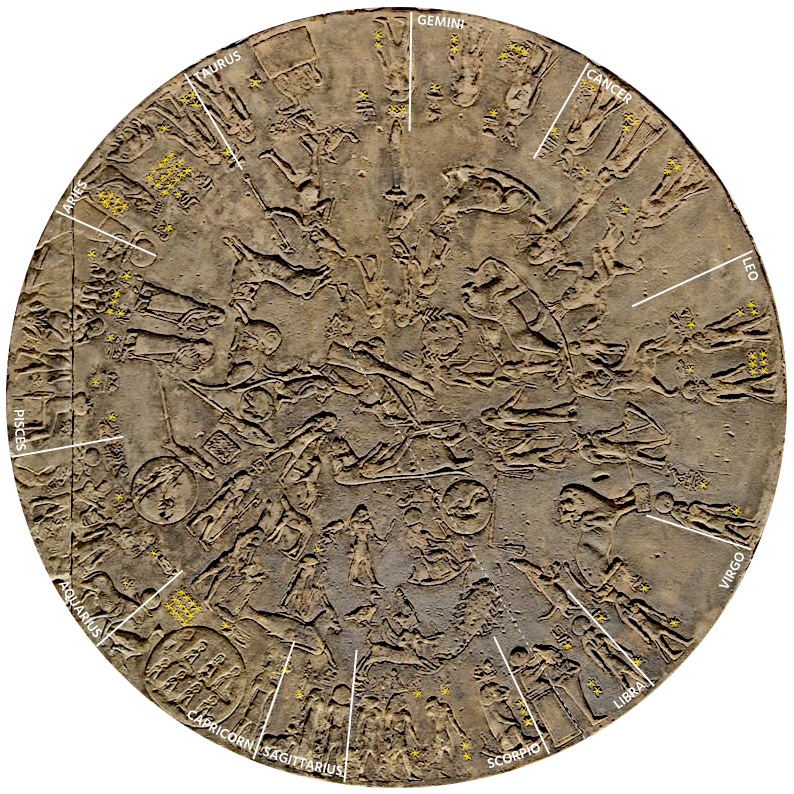The Dendera Zodiac
The Moon
The central circle containing the planets and the zodiac section around it
have been designed and carved in deliberately offset positions relative to the outer frame and require calibrating by rotation.
This website animates the sculpture using the NASA DE441 and DE431 ephemerides, which contain the highly accurate positions of the solar system planets, as its data sources for the angular rotations that are applied to the sculpture's component parts. This data is available in the right panel of this page in the 'technical data' tab. The animation can be reset at any time by clicking the button below and the zodiac carvings on the inner circle of the sculpture can be viewed at any time by clicking on the other button.
This website animates the sculpture using the NASA DE441 and DE431 ephemerides, which contain the highly accurate positions of the solar system planets, as its data sources for the angular rotations that are applied to the sculpture's component parts. This data is available in the right panel of this page in the 'technical data' tab. The animation can be reset at any time by clicking the button below and the zodiac carvings on the inner circle of the sculpture can be viewed at any time by clicking on the other button.
(Click and hold)
The first task with the sculpture is to align the Earth's orbit (the Ecliptic) reference direction known as the 'origin of right ascension', and previously confusingly called the 'first point in Aries',
on the inner circle with an alignment point on the outer frame.
On the inner circle of the sculpture, which shows the night sky, the Ecliptic's origin of right ascension is marked out using the staff of the principal God located in the Taurus section of the zodiac, with the bottom of the staff defining the first point in Taurus. The validity of this alignment can be checked by knowing that the origin of right ascension rotates around the Ecliptic by 1 degree every 72 years and will be located at the first point in Pisces in the year 2597, therefore the angle between its position in 2597 and its position in 2729 BCE must be 73.97 degrees.
On the inner circle of the sculpture, which shows the night sky, the Ecliptic's origin of right ascension is marked out using the staff of the principal God located in the Taurus section of the zodiac, with the bottom of the staff defining the first point in Taurus. The validity of this alignment can be checked by knowing that the origin of right ascension rotates around the Ecliptic by 1 degree every 72 years and will be located at the first point in Pisces in the year 2597, therefore the angle between its position in 2597 and its position in 2729 BCE must be 73.97 degrees.
(Click and hold)
At the top of the outer frame is the static alignment location for the Ecliptic's origin of right ascension which is marked using the traditional symbol that looks like a set of ram's horns.
This is in fact the hook object that was found inside the lower northern shaft of the Great Pyramid and which perfectly fits the knee positions of the Gods that are located at the four cardinal
points of the outer frame. The inner circle marker can be aligned with the outer frame marker by rotating the inner circle by exactly 33.3 degrees in a clockwise direction by clicking on this button :
The second rotation that needs to be applied is to just the outer part of this circle where the zodiac division lines are marked and is 342.29 degrees in a clockwise direction, which can be
accomplished by clicking the next button. This rotation aligns the outer zodiac segments, marked by the white lines and the names of the zodiac symbols, with the carved zodiac elements of the inner circle,
placing the Pisces carving in Pisces section, the Taurus carving in the Taurus section etc. The exact value of the rotation angle is explained on a later page.
The Autumnal equinox can now be added to the outer frame using ephemeris data for the Earth which shows that this equinox occurred 181.368925 degrees of rotation around the elliptical
orbit after the Vernal equinox in the year 2729 BCE and is therefore offset by 1.368925 degrees clockwise from the line of the God's staff at the bottom of the illustration.
The final part of setting up the sculpture is to fill in the damaged section on the left side, where the winter solstice is shown, with 9 small circles which will represent the Sun and the eight planets of the
solar system. The centers of these circles fit exactly between the torsos of the two Gods on the left side of the sculpture, have a specific diameter when measured angularly from the center of
the sculpture and are placed touching each other.
The Dendera Zodiac is now in its initial position and the planets can be identified and reverse engineered, starting with the Earth's Moon.
Explanation
Technical data
The Moon, Taurus and Pisces
The model of the Moon on the inner circle is part of the sculpture of the night sky and shows the Moon along with its phase, which was 67.8% of the way between a new moon and
a full moon at the time of the 2729 BCE winter solstice. The phase is aligned with the Pisces zodiac division and inner circle carvings.
A second model of the Moon has also been added on the sculpture's outer circle at the bottom, inline with the Autumnal equinox.
Astronomy rotation angles now need to be applied to the model, starting with the 'longitude of the ascending node' of the Moon. The longitude of the ascending node is the name given to the angle used to describe the rotation of the Moon's orbit relative to the reference frame. When it is applied both the Moon and the inner circle of the sculpture representing the night sky need to rotate. This is the third piece of obfuscation in the sculpture which correctly aligns the night sky with the outer Ecliptic reference frame at the time of the 2729 BCE winter solstice.
Astronomy rotation angles now need to be applied to the model, starting with the 'longitude of the ascending node' of the Moon. The longitude of the ascending node is the name given to the angle used to describe the rotation of the Moon's orbit relative to the reference frame. When it is applied both the Moon and the inner circle of the sculpture representing the night sky need to rotate. This is the third piece of obfuscation in the sculpture which correctly aligns the night sky with the outer Ecliptic reference frame at the time of the 2729 BCE winter solstice.
For all the solar system bodies, including the Moon, there are two astronomy angles that need to be applied. The first is known as the 'argument of periapsis' which defines where on the elliptical orbit the closest
point of the object to the central body occurs. In the case of the Moon the central body is the Earth and this periapsis has been given a specific name 'perigee'. The argument of periapsis
of the Moon can be applied by clicking the button :
As can be seen on the illustration the perigee point of the Moon is carved into the sculpture, as is the opposing location called 'apogee'. Click on the next button to highlight these two carved symbols.
The second of the two astronomy angles that needs to be applied to the Moon is the 'true anomaly' which is the elliptical angle describing how far around in its orbit the Moon is positioned
relative to the perigee location. This can now be applied using the button below.
The outer moon model is now on the left side of the sculpture, correctly positioned at the winter solstice on the Ecliptic reference frame and it is set into the damaged section
of the sculpture aligning with the third of the planet alignment circles because it represents the Earth-Moon system at the winter solstice of 2729 BCE.
The two Moons, one in the outer circle and one in the central circle, now align using the Moon's phase line as the reference line and the first point in Pisces is defined by the Moon's location as can be seen by the alignment of the Moon's line to the zodiac division line and the zodiac symbol carvings.
The important angle that has just been set up with the rotations is the angle between the Moon's final location at the first point in Pisces and the Autumnal equinox line where the Moon was initially positioned prior to rotation. This angle is exactly 88 degrees, which can be seen by clicking the following button.
The two Moons, one in the outer circle and one in the central circle, now align using the Moon's phase line as the reference line and the first point in Pisces is defined by the Moon's location as can be seen by the alignment of the Moon's line to the zodiac division line and the zodiac symbol carvings.
The important angle that has just been set up with the rotations is the angle between the Moon's final location at the first point in Pisces and the Autumnal equinox line where the Moon was initially positioned prior to rotation. This angle is exactly 88 degrees, which can be seen by clicking the following button.
(Click and hold)
All of the information required to solve the solar system planets on the Dendera Zodiac is now in place. Due to the logic used in the design the planets have to be solved in a particular order, the first of these being Venus. Click here to be taken to the Venus page.














